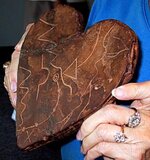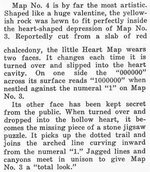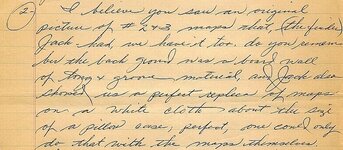EE THr
Silver Member
That Travis said the Heart was "yellowish" is one thing, but he also said it was made from a "slate-type" rock---
ref: Are the Peralta Stone Maps a Hoax?.
From page 12, left column, second complete paragraph---

The red Heart does fit the "slate-type rock" description, in that it seems to be layered---

But I haven't seen any "slate-type" quartzite examples. And it was correct that the Mineralogy Museum Director said it appeared to be quartzite---
From page 47, center column, fourth complete paragraph---

So, now we have that it's either of these two---
Chalcedony (KAL-suh-doe-nee)

or
Quartzite

Personally, I would describe the photo of the Heart, above, as "a reddish brown, slate-type rock."
I don't think that Travis's description, or the others in the McGee's story, describe the Heart in the photo. But I don't really have any interest in actually arguing that point. I just posted all this for anyone interested to consider, and form their own opinions.
On last discrepancy in the "McGee yellowish rock" heart, is that they never mention the breaks in it. I think that every other drawing and/or written description I've ever seen, always shows or lists the break lines as part of it. The breaks are quite an oddity, and to many treasure hunters are especially significant on any heart shape. Why no mention of breaks at all, from either the McGees or any of the persons they quoted in the story, concerning the heart? That alone seems very strange.
Well, I think I'm done with pointing out what I noticed in the McGee article, finally! (So anyone who was getting bored can rest at ease now.) Anyone who finds it interesting, can take it for what they feel it might be worth, if anything.
It was all very therapeutic for me, anyway.

ref: Are the Peralta Stone Maps a Hoax?.
From page 12, left column, second complete paragraph---

The red Heart does fit the "slate-type rock" description, in that it seems to be layered---

But I haven't seen any "slate-type" quartzite examples. And it was correct that the Mineralogy Museum Director said it appeared to be quartzite---
From page 47, center column, fourth complete paragraph---

So, now we have that it's either of these two---
Chalcedony (KAL-suh-doe-nee)

or
Quartzite

Personally, I would describe the photo of the Heart, above, as "a reddish brown, slate-type rock."
I don't think that Travis's description, or the others in the McGee's story, describe the Heart in the photo. But I don't really have any interest in actually arguing that point. I just posted all this for anyone interested to consider, and form their own opinions.
On last discrepancy in the "McGee yellowish rock" heart, is that they never mention the breaks in it. I think that every other drawing and/or written description I've ever seen, always shows or lists the break lines as part of it. The breaks are quite an oddity, and to many treasure hunters are especially significant on any heart shape. Why no mention of breaks at all, from either the McGees or any of the persons they quoted in the story, concerning the heart? That alone seems very strange.
Well, I think I'm done with pointing out what I noticed in the McGee article, finally! (So anyone who was getting bored can rest at ease now.) Anyone who finds it interesting, can take it for what they feel it might be worth, if anything.
It was all very therapeutic for me, anyway.




















